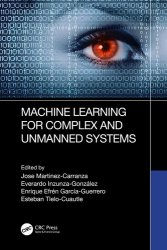Machine Learning for Complex and Unmanned Systems
- Добавил: literator
- Дата: 6-02-2024, 19:32
- Комментариев: 0
 Название: Machine Learning for Complex and Unmanned Systems
Название: Machine Learning for Complex and Unmanned SystemsАвтор: Jose Martinez-Carranza, Everardo Inzunza-González, Enrique Efrén García-Guerrero
Издательство: CRC Press
Год: 2024
Страниц: 386
Язык: английский
Формат: pdf (true)
Размер: 25.4 MB
This book highlights applications that include Machine Learning methods to enhance new developments in complex and unmanned systems. The contents are organized from the applications requiring few methods to the ones combining different methods and discussing their development and hardware/software implementation. The book includes two parts: the first one collects Machine Learning applications in complex systems, mainly discussing developments highlighting their modeling and simulation, and hardware implementation. The second part collects applications of Machine Learning in unmanned systems including optimization and case studies in submarines, drones, and robots. The chapters discuss miscellaneous applications required by both complex and unmanned systems, in the areas of Artificial Intelligence (AI), cryptography, embedded hardware, electronics, the Internet of Things (IoT), and healthcare. Each chapter provides guidelines and details of different methods that can be reproduced in hardware/software and discusses future research.
Features:
Provides details of applications using Machine Learning methods to solve real problems in engineering
Discusses new developments in the areas of complex and unmanned systems
Includes details of hardware/software implementation of Machine Learning methods
Includes examples of applications of different Machine Learning methods for future lines for research in the hot topic areas of submarines, drones, robots, cryptography, electronics, healthcare, and the Internet of Things
Part 1 is devoted to complex systems and includes seven chapters. Chapter 1 introduces a neural network model for Machine Learning tasks, but the authors found that simple echo state networks (ESNs) can be used instead. In ESNs, only the output layer weights are calculated by linear regression, which has a low computational cost. The study shows how ESNs with improved reservoir creation can solve classification tasks using simulated data and public databases. Chapter 2 discusses the challenge of monocular camera localization due to constant changes and proposes a review of state-of-the-art methodologies for this task. Traditional methods use end-to-end training with a large dataset, but this study presents Continual Learning (CL) strategies such as distillation, weights optimization, dynamic architectures, incremental labels, and latent replay to avoid the need for a large dataset and catastrophic forgetting. The aim is to describe the benefits and limitations of these methods for camera localization tasks from a single image. Chapter 3 proposes a dataset of images of three distinct fish species, each with a unique number of images, which are trained in different convolutional neural networks (CNN) for species identification applications. Chapter 4 presents a regression model that utilizes regression tree, random forest, and convolutional neural networks to model the nonlinear behavior of power amplifiers. The use of recursive subset partitioning with the regression tree model provides a fast runtime and highly accurate output estimates without overfitting. The ensemble model RT offers a single-step iteration solution for modeling sparse AM/AM behavior in a cascade setup that drives a Class AB power amplifier, which can address residual distortion present in the direct-conversion transmitter by tuning the parameters. Experimental results demonstrate the effectiveness of the proposed model for a wideband of LTE signals with varying input power levels. Chapter 5 highlights the increased use of video surveillance for security and operational efficiency and the need for effective data analysis techniques. The chapter focuses on anomaly detection in video surveillance systems, which requires unsupervised or semi-supervised learning techniques. The study describes the use of convolutional autoencoders, variational autoencoders, Long Short-Term Memory networks, and Generative Adversarial Networks for anomaly detection in video surveillance, including theoretical aspects and practical examples.
Part 2 is devoted to unmanned systems and includes nine chapters. Chapter 8 discusses the challenge of developing an artificial pilot capable of autonomously flying a drone in autonomous drone racing. Learning-based methods propose training an artificial pilot to associate sensorial data with fly commands, but current approaches cannot consider future events, such as an incoming turn. The study proposes augmenting the temporal analysis to consider data from future events observed through visual data and associated with flight commands optimized to follow a flight trajectory. The study discusses this approach in the context of the state of the art and an experimental framework to assess its effectiveness. Chapter 9 proposes optimizing UAV flight control’s performance using metaheuristics and comparing two relevant AI techniques, Differential Evolution and Accelerated Particle Swarm Optimization algorithms. The study also applies two control techniques, Sliding Mode Control and Proportional-Integral-Derivative control. The study presents UAV model development, trajectory methodology, and the application of metaheuristics to adjust controller parameters, followed by the results and discussion of tests for adjusting controller parameters and trajectory tracking. Chapter 10 focuses on object classification in aerial navigation using texture as an important feature. Chapter 11 explores using UAVs for air-ground communications to improve coverage in areas with poor or nonexistent coverage, with a focus on fifth-generation mobile communication (5G).
...
Finally, Chapter 16 shows a study that analyzes the classification of EEG signals using Machine Learning algorithms, such as: discriminant line analysis, decision trees, k-nearest neighbors, naive Bayes, and support vector machines.
This book can be used by graduate students, industrial and academic professionals to examine real case studies in applying Machine Learning in the areas of modeling, simulation, and optimization of complex systems, cryptography, electronics, healthcare, control systems, Internet of Things, security, and unmanned systems such as submarines, drones, and robots.
Скачать Machine Learning for Complex and Unmanned Systems
Внимание
Уважаемый посетитель, Вы зашли на сайт как незарегистрированный пользователь.
Мы рекомендуем Вам зарегистрироваться либо войти на сайт под своим именем.
Уважаемый посетитель, Вы зашли на сайт как незарегистрированный пользователь.
Мы рекомендуем Вам зарегистрироваться либо войти на сайт под своим именем.
Информация
Посетители, находящиеся в группе Гости, не могут оставлять комментарии к данной публикации.
Посетители, находящиеся в группе Гости, не могут оставлять комментарии к данной публикации.
